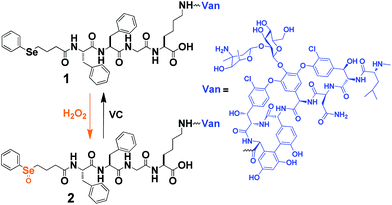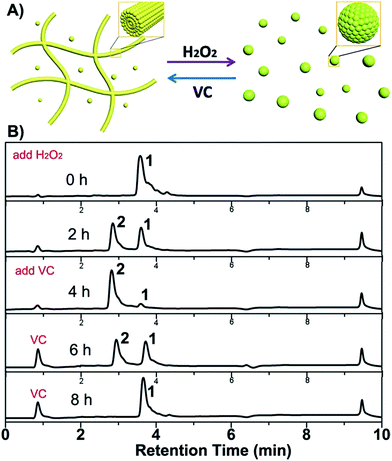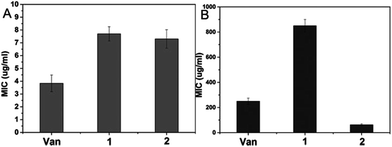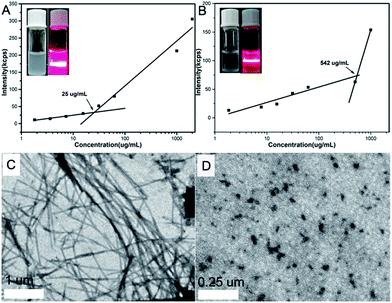Redox-controllable self-assembly and anti-bacterial activity of a vancomycin derivative†
Guoqin Chen‡
a,
Jianwu Zhang‡b,
Dongxia Lic,
Chunhua Renc,
Caiwen Oub,
Ling Wang*c and
Minsheng Chen*b
aDepartment of Cardiology, Guangzhou Panyu Central Hospital, Guangzhou 511400, P. R. China
bDepartment of Cardiology, Zhujiang Hospital of Southern Medical University, Guangzhou 510280, P. R. China. E-mail: gzminsheng@vip.163.com
cCollege of Pharmacy and Tianjin Key Laboratory of Molecular Drug Design, Nankai University, Tianjin 300071, P. R. China. E-mail: chwling@nankai.edu.cn
First published on 7th November 2014
Abstract
We report a selenium containing vancomycin derivative with redox-controllable self-assembly property and anti-bacterial activity.
Inspired by the self-assembled systems in biological systems (e.g. actin filament or tubulin assembles), researchers have developed many nanostructures with controllable and reversible self-assembly properties, which are generally achieved by redox reactions,1,2 light irradiation,3 ligand–receptor interactions,4,5 etc. These nanomaterials can not only mimic and help to understand the natural self-assembled systems, but also show big potential in drug delivery6 and tissue engineering.7 Among the building blocks for constructing these nanomaterials, those of small molecules have attracted increasing attention recently due to the ease of their design and synthesis, good biocompatibility, and easy degradability of small molecules.8 One strategy to generate reversible self-assembling small molecules is the integration of redox-active moieties with self-assembling small molecules. For instance, the introduction of a ferrocenoyl group,9 ruthenium complex,10 or selenium containing group1 to self-assembling short peptides has yielded supramolecular nanofibers and hydrogels with responsive properties. These studies highlight the advantages and versatility of redox-active compounds in the generation of reversible self-assembling systems.
The emergence of vancomycin resistant enterococci (VRE) has caused serious problems11 and the development of multivalent vancomycin (Van) has been demonstrated to be a powerful strategy to treat VRE, because multivalent Van derivatives show greatly enhanced binding affinities to bacterial cell wall peptide on VRE (e.g. D-Ala-D-lactate).12 For example, a self-assembling Pyren–Van conjugate could efficiently inhibit both gram positive bacterial and VRE5 due to the enhancement of local concentration of the antibiotics.13 Based on this information and our previous development of selenium containing self-assembling peptides,1 we opted to develop selenium containing Van derivative with redox-controllable self-assembly property and anti-bacteria activity.
As shown in Scheme 1, we firstly designed compound 1 as the selenium containing Van derivative, the selenium group can be oxidized to selenoxide by H2O2, leading to the formation of compound 2. The compound 2 can be transformed back to compound 1 by the vitamin C (VC). As many peptide derivatives with the amino acid sequences, FF or FFY have been demonstrated to possess excellent self-assembly property,14 compound 1 and 2 might self-assemble into different kinds of nanostructures. The synthetic route for the compound 1 was described in Scheme S-1.† In brief, after successfully preparing 4-(phenylselanyl)butanoic acid, it was then directly used for solid-phase peptide synthesis (SPPS) to produce PhSe(CH2)3COFFGK. The carboxyl group of Van was then conjugated with the amine group on the side chain of lysine (K) by a condensation reaction. Pure compound 1 was obtained by high-performance liquid chromatography (HPLC). Treating compound 1 with H2O2 (30%, 2 equiv. to compound 1) could successfully acquire compound 2. Compounds 1 and 2 could be dispersed in phosphate buffered saline (PBS, pH 7.0) at concentrations lower than 0.05 (0.5 mg mL−1) and 0.1 wt% (1 mg mL−1) respectively. The results revealed that the oxidized compound 2 was more soluble than the reduced compound 1 in aqueous solutions, which was consistent with our previous results.1
 | ||
| Scheme 1 Chemical structures of the selenium containing vancomycin (Van) derivatives and redox-triggered transformation. | ||
After obtaining the two designed compounds, their controllable and reversible self-assembly property was analyzed by liquid chromatography mass spectrometer (LC-MS). The LC-MS results (Fig. 1) showed that compound 1 was gradually converted to compound 2 upon the addition of H2O2, and the conversion reached the equilibrium after about 6 hours with a conversion percentage of 96.1% (Fig. S-6†). We then added 4 equivalent of VC (dissolved in PBS at 37 °C) to the resulting solution. Compound 2 could be completely transformed back to compound 1 after about 4 hours (Fig. 1 and S-8†). We also found that this redox cycle could be repeated for at least three times without obvious decomposition of the compounds. Biocompatible triggers for the formation of nanostructures have recently attracted great research interests due to their big potential for the in vivo application.15 The use of biocompatible agent VC to trigger the formation of nanostructure might advance the application of supramolecular nanostructures in tissue engineering, regenerative medicine, and controlled drug release.
 | ||
| Fig. 1 (A) Illustration of the redox-triggered transformation between micelles and nanofibers; and the HPLC spectra of one redox cycle triggered by H2O2 and VC. | ||
We then used dynamic light scattering (DLS) and transmission electron microscopy (TEM) to characterize the self-assembly property of compounds and self-assembled nanostructures, respectively. A light beam could be clearly observed when PBS solution of compound 1 or 2 was shined by a laser pointer (insets in Fig. 2A and B), suggesting that both compounds 1 and 2 could self-assemble into nanostructures. The DLS results showed that the critical micelle concentration (CMC) of compound 1 and 2 were 25 and 542 μg mL−1, respectively (Fig. 2A and B). The smaller CMC value of compound 1 indicated that compound 1 with reduced state have better self-assembly ability than compound 2. TEM images revealed that compound 1 exhibited nanofibers with a diameter of about 25 nm (Fig. 2C). Upon the addition of 2 equivalent of H2O2, the nanofibers changed to micelles with the size of about 10 nm (Fig. 2D). In order to test the reversible self-assembly property of the nanostructure, we then added 4 equivalent of VC to the resulting solution. The TEM image indicated that the micelles could be converted back to nanofibers (Fig. S-9†). The phenomenon indicated that the transformation between micelles of compound 2 and nanofibers of compound 1 was switchable by the redox control.
We then studied the bacterial inhibition capacity of compounds 1 and 2 with different self-assembly properties. Two bacteria strains, Van sensitive strain of Bacillus subtilis and Van resistant enterococci (VRE) of Enterococcus faecalis, were chosen as model organisms. Standard broth microdilution assay was used to investigate the antibacterial activity of compounds 1 and 2. As shown in Fig. 3, for Bacillus subtilis, the minimum inhibition concentration (MIC) of compounds 1 and 2 were about 7.8 and 7.3 μM, respectively, which was comparable to that of parent Van molecule (3.5 μM). For VRE Enterococcus faecalis, the MIC values of compound 1, 2 and the parent Van were 850, 62.5, and 250 μM, respectively, indicating that oxidative Van derivative compound 2 possessed the best inhibition capacity to the VRE Enterococcus faecalis. For a solution containing 400 μM of compound 1, it could not inhibit the growth of VRE Enterococcus faecalis. However, in the presence of 2 equiv. of H2O2, the solution could inhibit the growth of the VRE bacteria. Such switchable anti-bacterial activity was similar to those of biological systems that use kinase/phosphatase to regulate their activity.16 The better inhibition capacity of compound 2 to VRE Enterococcus faecalis than compound 1 in nanofiber form was probably due to the higher surface areas of micelles than nanofibers at the same concentration. This observation was also consistent with our previous results that the catalytic activity of artificial esterase in nanospheres was higher than that in nanofibers. These results provided useful information to design nanomaterials with controllable bioactivities.
 | ||
| Fig. 3 Minimum inhibition concentration (MIC) of Van and compounds 1 and 2 to inhibit (A) Bacillus subtilis and (B) VRE Enterococcus faecalis investigated by standard broth microdilution assay. | ||
In summary, we reported in this study on selenium containing Van derivatives with redox-controllable self-assembly property and anti-bacterial activity. The transformation between self-assembled nanostructures is reversible and the nanostructures can be regulated by redox triggers. The different stages of the self-assemblies exhibited different bacterial inhibition capacities. Therefore, the anti-bacterial activity of the compounds can be controlled and is switchable. Our system of selenium-containing peptides with reversible transformations between different kinds of nanostructures or between dissociated and self-assembled stages could be used to switch and control the activity of bioactive molecules. We believe that this study will lead to the development of nature-mimicking smart materials with promising properties.
Acknowledgements
This work is supported by National Natural Science Foundation of China (31370964, 51203078, and 51173060), Tianjin MSTC (12JCYBJC11300), and Program for Changjiang Scholars and Innovative Research Team in University (IRT13023).Notes and references
- X. Miao, W. Cao, W. Zheng, J. Wang, X. Zhang, J. Gao, C. Yang, D. Kong, H. Xu, L. Wang and Z. Yang, Angew. Chem., Int. Ed., 2013, 52, 7781 CrossRef CAS PubMed.
- (a) N. V. Lakshmi, D. Mandal, S. Ghosh and E. Prasad, Chem.–Eur. J., 2014, 20, 9002 CAS; (b) Y. Wang, H. Wang, G. Liu, X. Liu, Q. Jin and J. Ji, Macromol. Biosci., 2013, 13, 1084 CrossRef CAS PubMed.
- (a) N. S. Kumar, S. Varghese, G. Narayan and S. Das, Angew. Chem., Int. Ed., 2006, 45, 6317 CrossRef CAS PubMed; (b) W. Cao, X. Zhang, X. Miao, Z. Yang and H. Xu, Angew. Chem., Int. Ed., 2013, 52, 6233 CrossRef CAS PubMed; (c) N. R. Gandavarapu, M. A. Azagarsamy and K. S. Anseth, Adv. Mater., 2014, 26, 2521 CrossRef CAS PubMed.
- (a) X. Zhang, X. Chu, L. Wang, H. Wang, G. Liang, J. Zhang, J. Long and Z. Yang, Angew. Chem., Int. Ed., 2012, 51, 4388 CrossRef CAS PubMed; (b) C. Yang, D. Li, Z. Liu, G. Hong, J. Zhang, D. Kong and Z. Yang, J. Phys. Chem. B, 2012, 116, 633 CrossRef CAS PubMed.
- B. G. Xing, C. W. Yu, K. H. Chow, P. L. Ho, D. G. Fu and B. Xu, J. Am. Chem. Soc., 2002, 124, 14846 CrossRef CAS PubMed.
- (a) S. Sur, J. B. Matson, M. J. Webber, C. J. Newcomb and S. I. Stupp, ACS Nano, 2012, 6, 10776 CAS; (b) A. A. Aimetti, A. J. Machen and K. S. Anseth, Biomaterials, 2009, 30, 6048 CrossRef CAS PubMed.
- (a) B. P. Purcell, D. Lobb, M. B. Charati, S. M. Dorsey, R. J. Wade, K. N. Zellars, H. Doviak, S. Pettaway, C. B. Logdon, J. A. Shuman, P. D. Freels, J. H. Gorman 3rd, R. C. Gorman, F. G. Spinale and J. A. Burdick, Nat. Mater., 2014, 13, 653 CrossRef CAS PubMed; (b) J. Boekhoven and S. I. Stupp, Adv. Mater., 2014, 26, 1642 CrossRef CAS PubMed.
- (a) H. Wang, Z. Yang and D. J. Adams, Mater. Today, 2012, 15, 500 CrossRef CAS; (b) G. Fichman and E. Gazit, Acta Biomater., 2014, 10, 1671 CrossRef CAS PubMed; (c) R. V. Ulijn and A. M. Smith, Chem. Soc. Rev., 2008, 37, 664 RSC; (d) X. Du, J. Zhou and B. Xu, Chem. – Asian J., 2014, 9, 1446 CrossRef CAS PubMed; (e) Z. Luo and S. Zhang, Chem. Soc. Rev., 2012, 41, 4736 RSC.
- (a) Z. Sun, Z. Li, Y. He, R. Shen, L. Deng, M. Yang, Y. Liang and Y. Zhang, J. Am. Chem. Soc., 2013, 135, 13379 CrossRef CAS PubMed; (b) Y. Wang, R. Huang, W. Qi, Z. Wu, R. Su and Z. He, Nanotechnology, 2013, 24, 465603 CrossRef PubMed.
- Y. Zhang, B. Zhang, Y. Kuang, Y. Gao, J. Shi, X. X. Zhang and B. Xu, J. Am. Chem. Soc., 2013, 135, 5008 CrossRef CAS PubMed.
- B. E. Murray, N. Engl. J. Med., 2000, 342, 710 CrossRef CAS PubMed.
- (a) M. Mammen, S. K. Choi and G. M. Whitesides, Angew. Chem., Int. Ed., 1998, 37, 2755 CrossRef CAS; (b) J. H. Rao, J. Lahiri, R. M. Weis and G. M. Whitesides, J. Am. Chem. Soc., 2000, 122, 2698 CrossRef CAS; (c) J. H. Rao, J. Lahiri, L. Isaacs, R. M. Weis and G. M. Whitesides, Science, 1998, 280, 708 CrossRef CAS; (d) C. Ren, H. Wang, X. Zhang, D. Ding, L. Wang and Z. Yang, Chem. Commun., 2014, 50, 3473 RSC.
- J. C. Tiller, Angew. Chem., Int. Ed., 2003, 42, 3072 CrossRef CAS PubMed.
- (a) X. Yan, P. Zhu and J. Li, Chem. Soc. Rev., 2010, 39, 1877 RSC; (b) M. Reches and E. Gazit, Science, 2003, 300, 625 CrossRef CAS PubMed; (c) C. Ou, J. Zhang, X. Zhang, Z. Yang and M. Chen, Chem. Commun., 2013, 49, 1853 RSC.
- (a) C. M. Micklitsch, P. J. Knerr, M. C. Branco, R. Nagarkar, D. J. Pochan and J. P. Schneider, Angew. Chem., Int. Ed., 2011, 50, 1577 CrossRef CAS PubMed; (b) C. J. Bowerman and B. L. Nilsson, J. Am. Chem. Soc., 2010, 132, 9526 CrossRef CAS PubMed.
- (a) Z. Yang, G. Liang, L. Wang and B. Xu, J. Am. Chem. Soc., 2006, 128, 3038 CrossRef CAS PubMed; (b) G. von Maltzahn, D. H. Min, Y. Zhang, J. H. Park, T. J. Harris, M. Sailor and S. N. Bhatia, Adv. Mater., 2007, 19, 3579 CrossRef CAS; (c) J. Zhang, J. Gao, M. Chen and Z. Yang, Antioxid. Redox Signaling, 2014, 20, 2179 CrossRef CAS PubMed.
Footnotes |
| † Electronic supplementary information (ESI) available: Synthesis and characterization of the compounds, LC-MS results of the conversion between compounds 1 and 2, TEM image of solution of 2 treated with VC, details experimental procedure of MIC assay. See DOI: 10.1039/c4ra12093k |
| ‡ The authors pay equal contributions to this work. |
| This journal is © The Royal Society of Chemistry 2014 |

